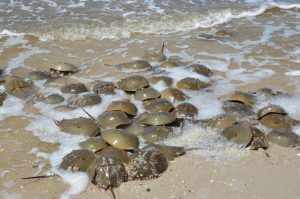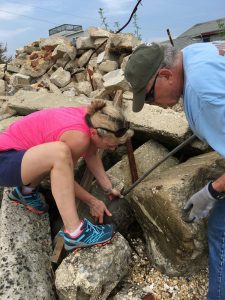by Dr. Lisa Ferguson, Director of Research and Conservation
 Each spring, the Delaware Bay plays host to one of nature’s great spectacles as hundreds of thousands of horseshoe crabs – the largest concentration in the world – come ashore to spawn. They are followed by countless migrating shorebirds that descend on the Bay beaches to feed on the excess of horseshoe crab eggs lining the shore. These crabs face threats from a variety of sources, and during spawning are vulnerable to exposure and predators after being flipped over by waves or becoming trapped by obstacles on the beach.
Each spring, the Delaware Bay plays host to one of nature’s great spectacles as hundreds of thousands of horseshoe crabs – the largest concentration in the world – come ashore to spawn. They are followed by countless migrating shorebirds that descend on the Bay beaches to feed on the excess of horseshoe crab eggs lining the shore. These crabs face threats from a variety of sources, and during spawning are vulnerable to exposure and predators after being flipped over by waves or becoming trapped by obstacles on the beach.
The reTURN the Favor (RTF) program continues to do significant good for the Delaware Bay horseshoe crab population, demonstrating just how much can be accomplished for conservation through collective action. After receiving training each year, RTF volunteers sign up to rescue crabs that become stranded on New Jersey beaches during spawning, and submit data from their walks. It has been estimated that 10 percent of stranded crabs eventually die. To reduce these preventable losses to this recovering population, nine groups work together through the RTF program to sponsor Delaware Bay beaches in Cape May and Cumberland counties, and around 100 volunteers lead walks for the program each year from May – July.
 Since the program started in 2013, over 685,000 horseshoe crabs have been rescued, on nearly 4,000 walks. This good is accomplished by RTF volunteers willing to bear the late nights, gnat-attacks, and back-bending work to rescue crabs, one by one by one. Their dedication to helping horseshoe crabs and the health of the Delaware Bay ecosystem is inspiring, and each year we take note of program milestones. Last year, the program surpassed over half a million crabs rescued, and the accomplishments of the program were recognized with a Governor’s Excellence Award. In 2020, despite a shortened season, fewer volunteers, and safety restrictions compelled by Covid-19, the program turned out its highest total yet, with each RTF volunteer pitching in like never before to rescue stranded crabs.
Since the program started in 2013, over 685,000 horseshoe crabs have been rescued, on nearly 4,000 walks. This good is accomplished by RTF volunteers willing to bear the late nights, gnat-attacks, and back-bending work to rescue crabs, one by one by one. Their dedication to helping horseshoe crabs and the health of the Delaware Bay ecosystem is inspiring, and each year we take note of program milestones. Last year, the program surpassed over half a million crabs rescued, and the accomplishments of the program were recognized with a Governor’s Excellence Award. In 2020, despite a shortened season, fewer volunteers, and safety restrictions compelled by Covid-19, the program turned out its highest total yet, with each RTF volunteer pitching in like never before to rescue stranded crabs.
We are learning and doing much more through the program, by identifying hazardous areas on the beaches where crabs become stuck, understanding conditions that heighten strandings, and taking action to reduce these risks. A grant through the US Fish & Wildlife Partners for Fish and Wildlife Program allowed us to remove impingement hazards on spawning beaches to benefit the crabs and the migratory shorebirds that depend on their eggs for food. In an effort to further reduce stress on the crabs, we recently developed a sign-on letter to petition the FDA to recognize a synthetic alternative to Limulus ambeocyte lystate, a component of horseshoe crab blood, for biomedical uses.
In addition to our dedicated volunteers and program partners, we have been lucky to have programmatic support from Ørsted Wind Energy in 2019 and 2020. You can help too, through our horseshoe crab adoption program. Your symbolic adoption directly helps fund critical research and conservation activities. Learn more at wetlandsinstitute.org/adopt/.
